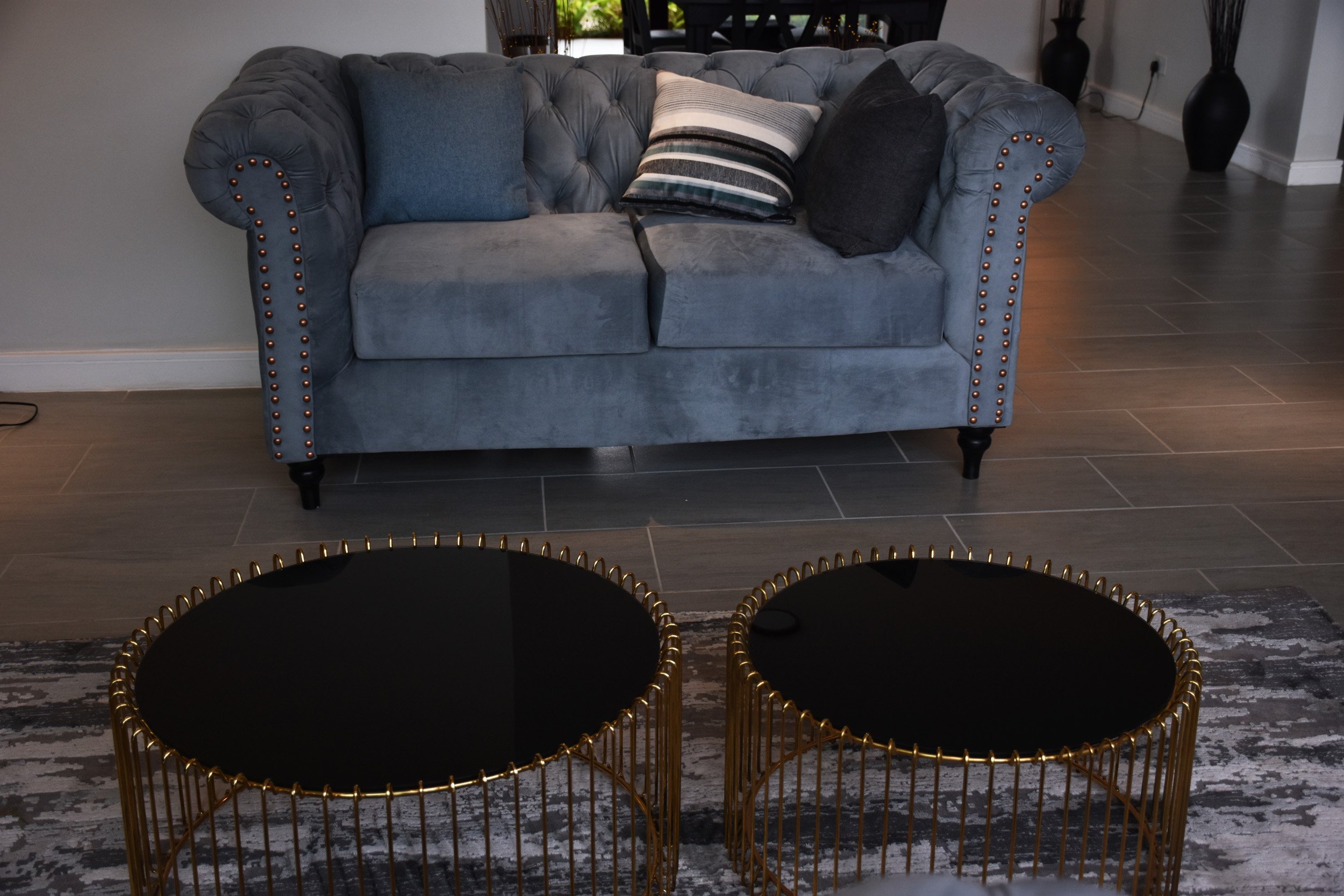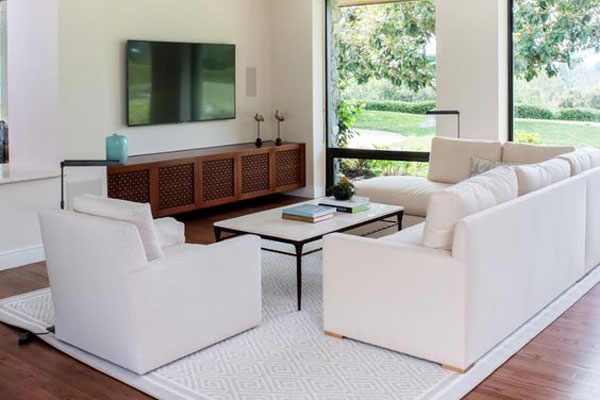Prime
Expert tips for trendy colours and furniture

Velvet sofas have made a big comeback. Photos/Promise Twinamukye.
What you need to know:
- When it comes to home decor, staying on trend with colours and furniture can transform a space and keep it looking fresh and stylish. For 2024, rich jewel tones like emerald green, sapphire blue, and deep burgundy are popular choices.
The television often serves as the focal point of a home, delivering a mix of news and entertainment that brings people together in the living room. The arrangement of this space, including the distance between the sofa and the TV, the choice of chairs, and other layout considerations, plays a key role in creating a comfortable and functional area.
Distance from the TV
Karyn Bagera Mugabo, a senior interior designer at Dreyz Interior advises that the placement of a television in relation to a sofa is a crucial consideration because the seemingly simple arrangement can significantly impact the viewing experience and overall ambiance of a room.
“The optimal distance between a sofa and a television is not arbitrary but is based on specific factors that contribute to comfort, visual clarity, and a balanced aesthetic. The primary factor influencing the ideal sofa-to-TV distance is the size of the television screen,” she notes.
Experts from House of Yakobo and Noel (HY&N), a design brand from Uganda, suggest that the optimal distance between the sofa and TV should be about twice the diagonal width of the TV screen. For example, if you have a 50-inch TV, aim for a distance of approximately 100 inches (or around two and a half metres) from the sofa to the screen. Interior and architectural designer Phillip Luwemba notes that TVs between 24 and 40 inches should ideally be viewed from at least one and a half metres away. For larger TVs, between 40 and 60 inches, a minimum viewing distance of two meters is suggested.
Room layout
The space between the TV and sofa also depends on the size of the room. In smaller rooms, where the sofa might be closer to the TV, it is essential to leave some open space to avoid a cluttered feel. “In larger rooms, adding extra seating or decorative elements can help balance the space and prevent it from feeling too vacant,” says Luwemba.
Bagera says beyond visual clarity, the distance between a sofa and a television also plays a significant role in creating a comfortable and inviting seating arrangement.
As such, a well-spaced arrangement allows for ample legroom and prevents viewers from feeling cramped or crowded. Additionally, it provides a sense of openness and airiness in the room, making it more conducive to relaxation and enjoyment.
“As a rule of thumb, it is best to keep the space between the TV and sofa simple. Using a minimalist approach would make the space appear bigger and reduce clutter. Items such as a centre rug and coffee table are enough,” House of Yakobo and Noel urge. Luwemba adds that a chandelier, centre table or an ottoman depending on setting, or all the above can be introduced in the space in-between. Notably, he observes that spaciousness is great but not to a point of a space looking empty.
Bagera notes that the space between the sofa and the television can contribute to the overall aesthetic of the room, allowing for the placement of decorative elements, such as side tables, centre tables and plants that can enhance the visual appeal and functionality of the space.

A well-spaced arrangement allows for ample legroom and prevents viewers from feeling cramped or crowded.
“These elements can create a sense of balance and symmetry, while also providing functional surfaces for remote controls, snacks, or drinks. You can also add a bench or ottoman to increase the sitting space in addition to the sofa. Maintaining an appropriate distance between a sofa and a television is not only essential for comfort and visual clarity but also for creating a harmonious and inviting living space,” she says.
By following the general guidelines and considering the specific dimensions of your room and television, she argues that you can ensure that your seating arrangement is both functional and aesthetically pleasing.
Colours
Bagera recommends commonly available black television because black is easy to pair with any colour of the sofa set you decide to get.
Luwemba also recommends black because it blends well with various colours. However, he is quick to add that this is not a law that should not be broken because some people love unique colours which are trending now.
“People today have a wider palette and an equally wider selection. But when selecting style and aesthetic are crucial. When in doubt, get a professional as your third-party advisor because they are better informed about the materials and their durability under particular conditions,” he says.
Choosing sofas
When selecting chairs for the living room, consider comfort, style, and scale. Opt for sofas and chairs that match the room’s size and decor. In smaller rooms, choose compact, multifunctional furniture to maximise space. In larger areas, you can explore various styles and materials, such as leather, fabric, or upholstered options, to complement the overall design.
Bagera recommends velvet because it is luxurious and inviting. The catch is that velvet chairs have made a significant comeback because their soft texture and rich colours add a touch of elegance to any room.
Bold and modern, chairs with geometric shapes, such as curved backs or tapered legs, are a popular choice for contemporary interiors. She also recommends less bulky sofas are in trend because they easily fit in spaces and they are not heavy or hard to assemble since a lot of people are into Do It Yourself (DIYs).
“Sustainable and eco-friendly chairs made from natural materials such as rattan, bamboo, or jute are becoming increasingly sought after.,” she adds.
House of Yakobo & Noel notes that antique and vintage styles, dark wood furniture, curved furniture pieces instead of sharp lines, earth toned furniture will compete with bolder statements and custom-made pieces are on the rise.
“The detailing in the furniture matters. Eco-friendly fabric and material for a sustainable finish ( bamboo) and oversized furniture is back on the popularity list. Comfort is key for many homes,” House of Yakobo and Noel further notes.
When purchasing a good quality sofa set, one must consider the type of material used to make the sofa frames. Examples of durable material used for frame-making include wood, steel, aluminium, metal and plywood for sure sofa strength and durability.
“You can opt for fabrics that are inherently stain-resistant, such as performance fabrics, microfibre, or leather. These materials are treated to repel spills and stains, making them easier to clean,” Bagera explains.
Ratios
House of Yakobo and Noel suggests using an estimated ratio of 60:40. “40 percent of the space can be left open for foot traffic/movement, and the 60 percent can be dressed with other relevant decor and/or furniture,” they recommend.
The portion that dressed with decor and furniture should be strategically designed so as to accommodate enough room to move about, while taking into consideration the needs of those using the space.





